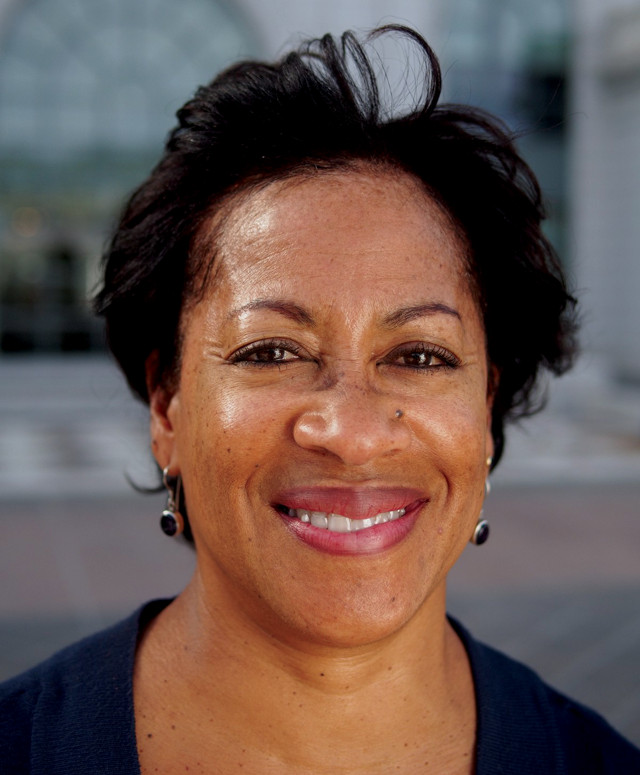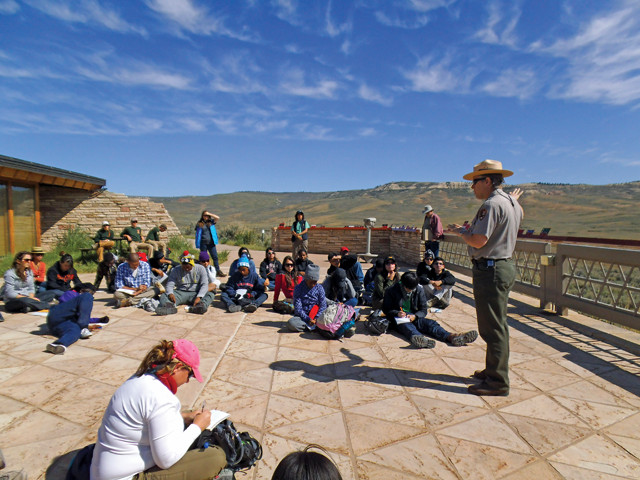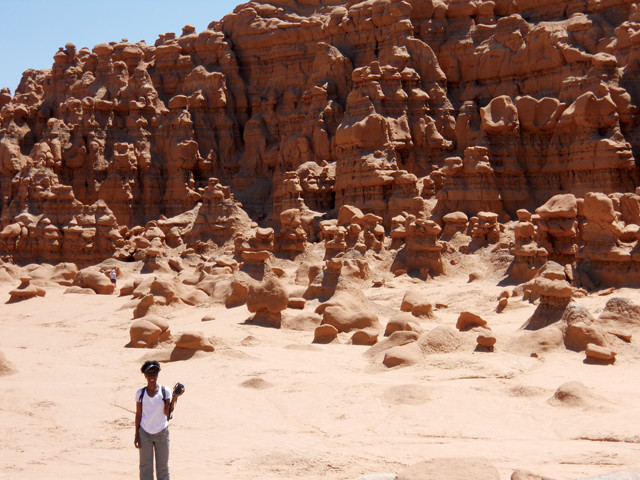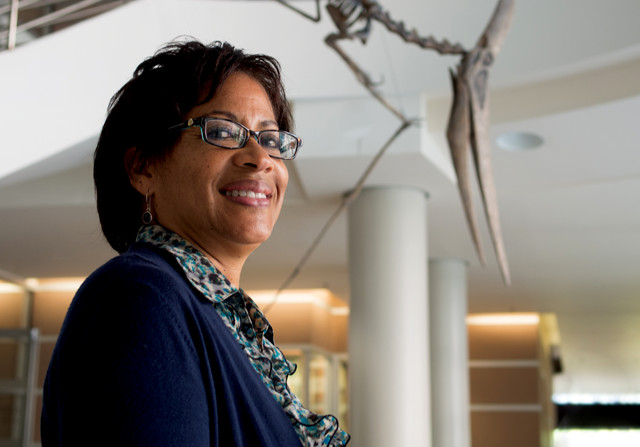
by Thea Boodhoo Wednesday, August 16, 2017

Lisa White, assistant director of Education and Public Programs at the University of California Museum of Paleontology, at the 2016 meeting of the Society of Vertebrate Paleontology. Credit: Thea Boodhoo.
As a college student at San Francisco State University, Lisa D. White’s first choice of major was photography. She was drawn to landscapes, and dreamed of becoming “the black female Ansel Adams,” she tells me, surrounded by fossils. We’re in a lab at the University of California Museum of Paleontology (UCMP) in Berkeley, where she is assistant director of Education and Public Programs. She is also a micropaleontologist, and from 1990 until joining UCMP in 2012, she was professor of geology and later associate dean at San Francisco State University.
It wasn’t until her junior year of college that she even considered geoscience as a profession. Her love of landscapes attracted her to a geology nonmajors class, and a new world suddenly opened up. She changed her major and got an internship with the U.S. Geological Survey. With the guidance of mentors and advisors, she received a doctorate in earth science in 1989 from the University of California, Santa Cruz, where she researched fossil diatoms in the Miocene Monterey Formation.
Her enthusiasm for geoscience is obvious and infectious. To think that she almost wasn’t a scientist at all raises the question: How many potential scientists never took that geology class? How many Lisa Whites are missing from the geosciences?
White has wondered the same thing, and throughout her career, she’s gone out of her way to work with youth who might not otherwise be exposed to geoscience. She creates what she calls “critical incidents” — experiences that first enlighten young people, especially high school students, about earth science. If you wait too long, she notes, you may miss out on pulling students into the geosciences. By the time students take their first college geology class, many have already decided to do something else with their lives. “If [high school] students can have a positive experience or series of experiences with geoscience — a great class or an outdoor learning opportunity, for example — then that enlightens them,” making them think, for the first time perhaps, about becoming an earth scientist themselves, she says. By the time they reach college, having a friend in a geoscience class or major can also help. But surveys show that essentially, if you don’t know someone who can share earth science with you outside of school, you’re extremely unlikely to ever become a geoscientist, White says.
For many students, Lisa White is that person. It’s a role she’s accepted wholeheartedly. She takes an “informal learning” approach, which she describes as “any learning opportunity that’s not in a structured classroom.” Informal learning could take place at a museum, in an after-school program, or outdoors, she says, and it’s the key to exposing students to geoscience early enough to choose it as a career. Much of her work in this area has been centered on student fossil hunts in the Bay Area and beyond.

A group of students in the Minority Education Through Traveling and Learning in the Sciences (METALS) program on a field trip at Fossil Butte National Monument in Wyoming in 2012. Credit: Lisa White.
These experiences can not only open up new vistas for students, but a new understanding of the world. Several years ago, she hosted a summer geology workshop for high school students that culminated in a geology-themed road trip to Yellowstone National Park. At one stop in Idaho, a young man in the group asked a question that struck her as particularly meaningful. He stood at the edge of a deep channel cut through a flood basalt plateau. As she reminded him of the geological processes that formed the gorge, he asked, “Is this real?” She was taken aback; this was an intelligent young man on his way to Harvard. She asked what he meant. “Well, what we’re seeing, like this channel, is it real?” It occurred to her then that even after all the studying, after absorbing the academic knowledge of what earth processes could do, nothing had prepared him for the reality of nature — of seeing the proof in person. “If you have no direct connection with nature, if you haven’t really seen — on a scale of landscapes — these features, then sometimes you don’t really know how to react.”
To White, this was an important lesson: People who don’t have direct experience with nature don’t understand what it’s capable of. But as society deals with natural disasters, climate change, and many questions of public policy that involve nature and the environment, an understanding of geoscience is a crucial part of being an informed citizen. This is part of what motivates her to keep teaching.
Informal learning doesn’t require a dramatic landscape — it can happen online. This is especially important when, like White, you’re tasked with doing outreach for a research museum whose collections aren’t on display for the public. “When the web was in its infancy in the early ‘90s,” White says, “UCMP made a conscious decision to use the web as a vehicle to highlight the research done here and make public connections.” Building on this legacy, White’s UCMP Education and Public Programs team — including a web manager, a graphic artist, a science writer and a postdoctoral scholar — is creating an online experience called “Understanding Global Change” that is scheduled to launch in early 2018. It will be the third in a series of interactive learning experiences that includes “Understanding Evolution” and “Understanding Science,” which have been running since 2004 and 2007, respectively.
White has found the informal learning approach especially important for reaching diverse, urban high school students. She’s led two programs focused on this demographic: SF-ROCKS (Reaching Out to Communities and Kids with Science in San Francisco) from 2001 to 2008, and its successor METALS (Minority Education Through Traveling and Learning in the Sciences) from 2010 to 2015. METALS had partner programs at the University of Texas at El Paso, University of New Orleans and Purdue University. Both programs were funded by the National Science Foundation.
In 2015, METALS went to Montana’s dinosaur country. The student participants — ethnically diverse kids from the Bay Area as well as El Paso and New Orleans — had minimal experience with geoscience, and none with paleontology. “But some of the things they were finding were terrific,” she says. “And it brought out all this great skill in them — for observing, noticing details of bones.” One student in particular was a natural, she says. “This young man was so bright and he was always finding things.” One of his museum-quality discoveries now resides in the UCMP collections, and he’ll be a freshman at the University of California, Berkeley this fall. Reflecting on this, White notes, “I’m sure someone may have just written him off as just another young black man at a high school in Oakland,” a Bay Area city with a complicated history of racial tension.
White has long been a proponent of improving diversity in the geosciences. In 1988, she was appointed coordinator of the Minority Participation in the Earth Sciences Program at USGS, and in 2000 became chair of the Geological Society of America’s Committee on Minorities and Women in the Geosciences.

A participant in the METALS program at Goblin Valley State Park in Utah in 2010. Credit: Lisa White.
An important factor in improving diversity may be as simple as accurately conveying what it’s like being a geoscientist, White says. Recent research has shown that the work in STEM fields is perceived as solitary, while students from underrepresented groups tend to be more interested in careers that involve working with and helping others. “I think in any science, we’re still sort of battling that image that we work alone in labs, everything we do is at a bench, and that it’s very isolated,” she says. “And something I really love about geoscience is that that’s rarely been my experience.”
Communal experiences in geoscience can range from collaborating on a paper across continents, to camping with a team at a dig site, to joining professional organizations like the Society of Vertebrate Paleontology (SVP), of which White is a member. At the SVP annual meeting in August, she hosted a roundtable at a workshop called “Solutions for Supporting a Diverse SVP Membership.” The increasing diversity of paleontology is a trend that many first became aware of at SVP 2016, when the prestigious Hix Preparators’ Grant was awarded to Sanaa El-Sayed, the first Middle Eastern woman to receive the grant.
Paleontology, by nature, is global. Most paleontologists collaborate with people from backgrounds at least as diverse as their fossil locales. “Having reliance on other individuals is a routine part of what we do,” White says. Her students, and anyone who’s turned off by the out-of-date stereotypes, may benefit from knowing that communities like SVP exist. One premise of the workshop was that current members have a responsibility to make sure new members from all backgrounds find a welcoming environment with opportunities for academic collaboration, fieldwork experience and even friendship.

White in the Valley Life Sciences Building at the University of California, Berkeley. Credit: Thea Boodhoo.
At the end of our interview, we left the lab for a tour of the UCMP paleontology collections. White enthusiastically pulled her favorite fossils from their drawers, and I found myself getting lost in the swirling crinoids of a particularly well-preserved limestone slab. I recalled her story of starting out in landscape photography. Even after she changed her major to geology, she would catch herself getting distracted by the scenery during fieldwork, often to the frustration of her professors. Today, when she notices students staring a little too long at what they’re supposed to be studying, she practices patience. That uninterrupted moment just might be the critical incident that inspires a career.
© 2008-2021. All rights reserved. Any copying, redistribution or retransmission of any of the contents of this service without the expressed written permission of the American Geosciences Institute is expressly prohibited. Click here for all copyright requests.